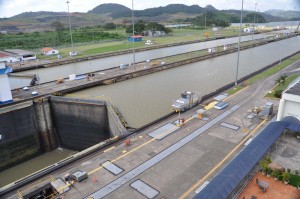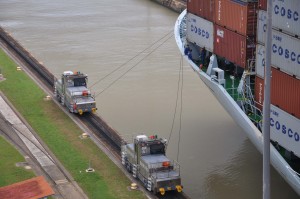We are all cleared to transit the Canal this Saturday (12/28)! Here is some basic info about the Canal and how to transits through.
The Canal is 48 miles long. It runs North and South. We’ll be transiting Northbound and it will take about 10 to 12 hours to transit through unless we hit heavy winds or have mechanical difficulties. We’ll motor the entire way (no sailing allowed) and most maintain a minimum of 5 knots and clear through in our allotted time.
We call this Friday (12/27) to confirm our appointment, and we will be assigned our time slot, told where to pick up our pilot advisor, whether we are a center tie or tied alongside a tug boat which will be tied to the side of the lock, and how much time we have to clear through without forfeiting our buffer deposit ($850). The advisor will help us lock through by managing communication with The Panama Canal Transit Control and providing piloting guidance – I’ll be at the helm. We’ll probably leave very early as the Northbound traffic is done in the morning and Southbound starts in the afternoon (which is why you are given 2 days to clear the Canal when coming from the Atlantic side). There are actually two sets of locks that run parallel, but both canals are used for traffic transiting the same direction, which is why they do Northbound then Southbound (usually).
We’ll first pick up our line handlers (4) who will help manage the lines (1 to 2 lines from the bow and 1 to 2 from the stern depending on how we lock through – side tie or center tie). Unlike other canals which use tug boats to help guide vessels through, the Panama Canal relies on locomotives, called Mules because they were originally mules before being replaced with locomotives. As the boat rises or falls within the lock, the line handlers have to take up or ease the lines accordingly.
The Canal consists of six locks. Three on the Pacific side used to raise us approximately 86 feet to Gatun Lake and three locks to lower us back down to the Atlantic Ocean. We’ll begin with the Miraflores Locks which there are two. We enter the first lock camber and the gate is closed. 26 million gallons of water will be gravity fed into the lock within 8 minutes. Gatun Lake supplies all the water which is the heart of the Canal making this all possible. Our boat will rise (hopefully) to the same level as the next lock, then the gates will open, we motor into the lock, gates close, and another 26 million gallons of water flow in. The water is fed in via pipes at the bottom of the locks. After clearing that lock we enter Miraflores Lake and travel a short distance to the final lock on the Pacific side (Pedro Miguel Lock). After clearing that lock we proceed through the Culebra Cut which is basically the top of a mountain that was blasted and excavated to create a channel (ditch) over it to Gatun Lake. Gatun Lake was created by damming up the mighty Chagres River; this lake used to be world’s largest artificial lake. It is about 18 miles across the lake to the Gatun Locks on the Atlantic side. Repeat the locking procedure in reverse and voilà …. we are in the Caribbean …. time for some rum!


